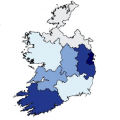Measuring Youth Unemployment
6 Nov 2013Introduction
This report analyses the available evidence surrounding the extent of youth unemployment in Ireland. Youth unemployment concerns those out of work between the ages of 15-24. This study will first outline evidence using the definition of youth unemployment provided by the International Labour Organization, before altering the method of aggregating unemployment statistics to reflect the greater role played by education in this age group. I then discuss recent trends within youth unemployment.
Labour Force Statistics
According to the International Labour Organisation1, the rate of unemployment is defined as the number of unemployed individuals divided by the total labour force.
The labour force is defined as “the proportion of a country’s working-age population that engages actively in the labour market, either by working or looking for work”2 . For an individual to be considered unemployed by this definition, they must be without work during the reference period, be currently available to work and are actively seeking work. These concepts are represented diagrammatically in Figure 1.
Figure 1: Breakdown of the Working Age Population
Figure 2 outlines two key components of labour force statistics. The columns represent the total number of individuals within the labour force for each age group, whereas the line chart indicates the rate of unemployment as defined by the labour force method. All values are for the second quarter of 2013.
Source: CSO3
Initially considering the ILO unemployment rate, relative to other age categories, the 15-24 years age cohort appears very high. Whereas the ILO unemployment rate seems to fall with each increase in age, these values all range between 10-15%; by contrast, the 15-24 years rate, at approximately 29.6%, is over double the value of any other age group. On the basis of this evidence alone, one might infer that unemployment is a significantly more prevalent issue for this age group than the rest of the population.
Participation in Education
A unique characteristic of those aged 15-24, which is less applicable to other age cohorts, is the greater degree of enrolment in education. One might expect there to be a greater propensity for those within this age range to be in some form of education, which comes at the opportunity cost of full participation within the labour force. Although the clustering of ages does not align with the ILO measures discussed previously, nevertheless the OECD4 provides some evidence of this phenomenon. In 2011, almost 93% of 15-19 year olds were enrolled in some kind of education in Ireland; for those aged between 20-29 this enrolment rate is calculated to be 22%. Although this does not allow a conclusive figure to be calculated for those in the 15-24 age group enrolled in education, it may be inferred that enrolment is likely higher for this group than elsewhere.
Unemployment and the Population
Given that a large proportion of the 15-24 age group are enrolled in education and thus not counted as part of the labour force, the traditional unemployment rate may create an incorrect impression of the situation facing young people. To overcome some of the shortcomings discussed in using the total labour force as the denominator in unemployment rate calculations, the total population aged 15-24 may be used as an alternative. This is known as the unemployment ratio.
Figure 3 below outlines this alternative measure of unemployment, calculated for the second quarter of 2013.
Source: CSO3,5
Figure 3 shows that unemployment as a proportion of the population is almost equivalent across the 15-24 and 25-34 age groups. This measure may be interpreted as follows; comparing a randomly selected individual from each age group in a given time period, both have an almost equal chance of being unemployed. The difference resulting from the use of the population as the denominator is stark when applying the same interpretation to labour force statistics, which may imply a randomly selected individual from the 15-24 age group has over twice the propensity to remain unemployed than a comparative individual in the 25-34 age group. Alongside this cross-sectional analysis, we may add a time dimension to compare unemployment rates and ratios over the last six years. As annual population statistics are only available for the month of April, the following annual figures concern values within the second quarter of each year.
Source: CSO3,5
Figure 4 shows a relative increase in the disparity between labour force and population estimates of youth unemployment. Whereas the 2008 estimates provide a difference of approximately 5.73%, this increases drastically in later periods, peaking at a difference of 19.25% in the second quarter of 2012, implying an increasing preference amongst young people for staying on in education over entering the labour force.
Total and Relative Unemployment
As well as potentially creating an incorrect impression of the situation facing young people, the youth unemployment rate may also give an incorrect impression of the unemployed population. Figure 5 below plots total numbers unemployed for both the 15-24 group and the cumulative other age groups. For the sake of continuity, I again use data from the second quarter of each year.
Source: CSO3,5
Figure 5 indicates that total unemployment has increased from approximately 131,000 in the second quarter of 2008 to slightly over 300,000 in the comparable period of 2013. Considering youth unemployment more specifically, a similar overall pattern is observed; numbers of unemployed young people increase over the period. The most drastic increase however is observed within the initial period; in the second quarter of 2009, youth unemployment rose by 38,300 from the previous year, to its peak over the period of 83,100. Although a general decline is observed over the rest of this period, the number of unemployed young people in the second quarter of 2013 is over 44% higher than the comparable number for 2008. The proportion of overall unemployment numbers that are contributed by 15-24 year olds has fallen since the onset of the employment crisis in 2008. Whereas over 34% of individuals in the second quarter of 2008 were aged 15-24, this proportion falls to approximately 22.5% in the second quarter of 2013. Thus, the general increase in unemployment has been driven more by other age groups than 15-24 year olds. To further emphasise this point, Figure 6 below outlines the relative contributions to total unemployment for each age group across this time period.
Source: CSO3,5
When considering the relative proportions of each age group, it shows that the percentage of unemployed persons contributed by the older three cohorts increases slightly over the sample period. However, the 25-34 age group is shown to contribute an increasing proportion of unemployed individuals, in comparison to a relative decline for the youth cohort.
Concluding Comment
It is important to note that the aim of this article is not to downplay the damaging effects of unemployment on young people or the damaging effects of youth unemployment on society as a whole. However, in order to design and implement appropriate policies, policy-makers should be informed of appropriate statistics.
4 OECD, Education at a Glance 2013, Table C2.1.














